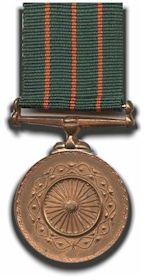
The Shaurya Chakra is an Indian military decoration awarded for valour, courageous action or self-sacrifice while not engaged in direct action with the enemy. It may be awarded to civilians as well as military personnel, sometimes posthumously. It is third in order of precedence of peacetime gallantry awards and comes after the Ashoka Chakra and the Kirti Chakra. It precedes the Yudh Seva Medal.[total recipients 2094]. [total awarded posthumously is 677].
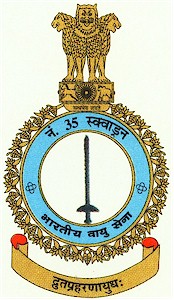
No. 35 Squadron IAF (Rapiers) operates as an electronic warfare and air superiority unit of the Indian Air Force (IAF). Based at Bakshi Ka Talab Airforce Station, No. 35 Squadron falls under the Central Air Command; and along with No. 108 Squadron forms an operational wing of the IAF. As of 2017, it is equipped with MiG-21M aircraft. The squadron was number plated on an unspecified date.

The Sena Medal is awarded to members of the Indian army, of all ranks, "for such individual acts of exceptional devotion to duty or courage as have special significance for the Army." Awards may be made posthumously and a bar is authorized for subsequent awards of the Sena Medal.
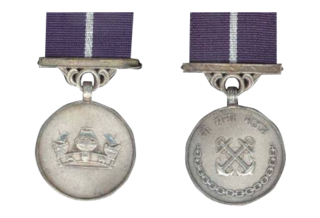
Nau Sena Medal is a gallantry award for servicemen in the Indian Navy.
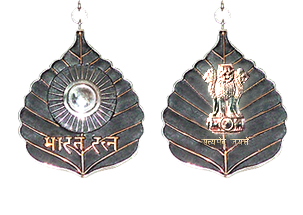
The Indian honours system is the system of awards given to individuals for a variety of services to the Republic of India. The categories of awards are as follows:
Wing Commander Trevor Keelor, VrC, VM was an officer of Indian Air Force who participated in the Indo-Pakistani War of 1965. He was honoured with a number of medals including the Vir Chakra and the Vayu Sena Medal. He had an elder brother, Denzil, who was also honoured for his service in the Indian Air Force. Both brothers have a Vir Chakra for the same feat of shooting down Pakistan Air Force F-86 Sabre fighters. It was the first time two brothers have received Vir Chakras for the same reason.

Ati Vishisht Seva Medal (AVSM) is a military award of India given to recognize "distinguished service of an exceptional order" to all ranks of the armed forces. The award is a peacetime equivalent of Uttam Yuddh Seva Medal, which is a Wartime Distinguished Service decoration.

The Vishisht Seva Medal (VSM) is a decoration of the Indian armed forces. It is awarded to recognize "distinguished service of a high order" to all ranks of the Indian Armed forces.

Param Vishisht Seva Medal (PVSM) is a military award of India. It was constituted in 1960 and since then it is awarded in recognition to peace-time service of the most exceptional order and may be awarded posthumously. All ranks of the Indian Armed Forces including Territorial Army, Auxiliary and Reserve Forces, Nursing officers and other members of the Nursing services and other lawfully constituted Armed Forces are eligible for the award.

The Sarvottam Yudh Seva Medal is India's highest wartime distinguished service decoration. It is awarded for the highest degree of distinguished service in an operational context, which includes times of war, conflict, or hostilities. The award is a war-time equivalent of the Param Vishisht Seva Medal, which is India's highest peacetime distinguished service decoration.
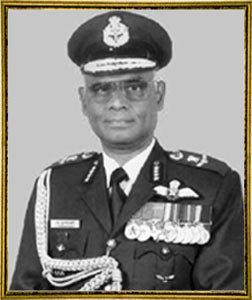
Air Chief Marshal Srinivasapuram Krishnaswamy PVSM, AVSM, VM & Bar, ADC is a former Air Officer in the Indian Air Force (IAF). He served as the 19th Chief of the Air Staff from 2001 to 2004. He raised the first electronic warfare squadron in the Indian Air Force. He has the rare distinction of having commanded three operational commands of the IAF - the Western, South-Western and Central Air Commands.

Air Marshal Sunderraman Neelakantan PVSM, YSM, VM, is a retired officer and was Air Officer Commanding-in-Chief (AOC-in-C), Southern Air Command of the Indian Air Force from 1 August 2016 to 1 March 2017. He was succeeded by Air Marshal Rakesh Kumar Singh Bhadauria.
The Sainya Seva Medal is a medal of the Indian Armed Forces. The medal is awarded in recognition of non-operational service under conditions of hardship and severe climate in specified areas.

Air Marshal Shyam Bihari Prasad Sinha, PVSM, AVSM, VM, ADC is a retired officer of Indian Air Force who served as Air Officer Commanding-in-Chief (AOC-in-C), Central Air Command from 1 January 2016 to 31 December 2018. He assumed office from Air Marshal Kulwant Singh Gill and was succeeded by Air Marshal Rajesh Kumar. AVSM, VM.

Air Marshal Raghunath Nambiar, PVSM, AVSM, VM & Bar is a retired officer of the Indian Air Force. He served as Air Officer Commanding-in-Chief (AOC-in-C), Western Air Command from 1 March 2019 to 31 October 2019.

Air Marshal Rajesh Kumar, PVSM, AVSM, VM, ADC is a former officer in the Indian Air Force. He last served as the Commander-in-Chief, Strategic Forces Command. He assumed office on 31 January 2021 following the retirement of Air Marshal Navkaranjit Singh Dhillon. Previously he served as AOC-in-C in Central Air Command and SASO in Eastern Air Command. He superannuated on 31 August 2021.

Air Marshal Arvindra Singh Butola, PVSM, VM, VSM is a retired officer of the Indian Air Force. He was the Air Officer Commanding-in-Chief (AOC-in-C), Training Command, and assumed office on 14 October 2019 succeeding Air Marshal Surendra Kumar Ghotia. Air Marshal AS Butola superannuated on 30 September 2020.

Air Marshal Amit Tiwari, PVSM, AVSM, VM is a retired officer of the Indian Air Force. He served as the Air Officer Commanding-in-Chief (AOC-in-C), Central Air Command. He assumed the office on 1 February 2021 succeeding Air Marshal Rajesh Kumar and served till 31 May 2021. He is succeeded by Air Marshal Richard John Duckworth. Previously, he served as AOC-in-C of Southern Air Command.

Air Marshal Sandeep Singh, PVSM, AVSM, VM is an officer in the Indian Air Force. Currently he is serving as the Vice Chief of the Air Staff, succeeding Vivek Ram Chaudhari. Previously, he served as the Air Officer Commanding-in-Chief (AOC-in-C), South Western Air Command.
The Videsh Seva Medal is a service medal of the Indian Armed Forces. It is presented to all ranks of the three services for services rendered outside India. It was instituted on 26 January 1960. It can also be awarded posthumously.


















